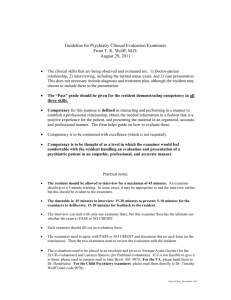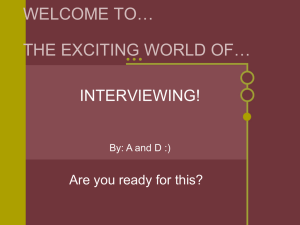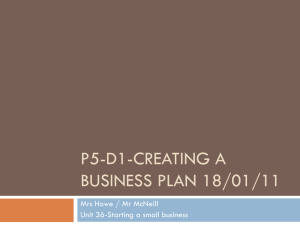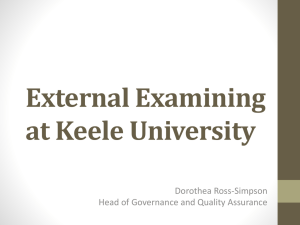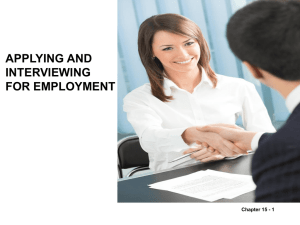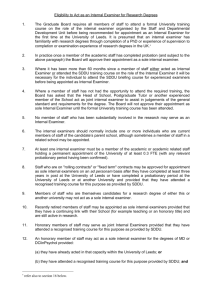Examiner Interviews * Best Practices
advertisement
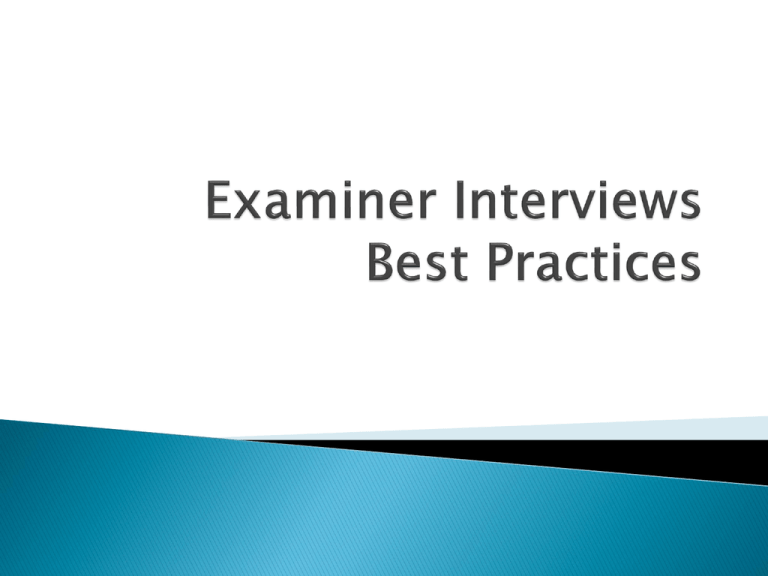
Interview Time FY 2008 – FY 2013 180,000 170,000 160,000 150,000 140,000 130,000 120,000 Hours 110,000 100,000 90,000 80,000 70,000 60,000 50,000 40,000 30,000 20,000 10,000 0 October November December January February 20 08 20 09 March 20 10 April 20 11 May 20 12 June July August September 20 13 23,503 hours in FY 2013, compared with 21,273 hours in FY 2012. 6,651 interview hours in FY 13 have been charged through the AFCP program. 2 100% Based on random samples of over 28,000 Allowances and Final Rejections from FY 2008 – FY 2012 99% % Compliance Rate 98% 97% 97.4% 96% 95% 96.3% 95.1% 94% 93% 93.3% 92% 91% 90% In-process In-process Allowance Allowance Compliance Rate Compliance Rate Compliance Rate Compliance Rate with Interview without Interview with Interview without Interview 12/3/12 • Useful content of a detailed Agenda may include: General intent and/or goal of interview Brief summary of arguments (if applicable) Applied references Evidence relied upon Proposed amendments • Not submitting an agenda is not a valid reason to deny an interview • Review the application history including the prior art • Understand the inventive concept • Identify allowable subject matter where appropriate • Be prepared to explain position of previous action • Use the appropriate Interview Summary form and fill out completely • Attach agenda and any items (including proposed amendments) provided for the interview • Be specifics regarding issues discussed • Clearly document all agreements • Agreement can be reached for various issues, such as allowability, interpretation of claim limitations, priority dates, application of case law, next steps to be taken, statutory subject matter, etc. • Make sure the record is complete 5 • Clarify Agreements Record Specific Issues Resolved Note Any Interpretations Agreed Upon Identify Allowable Subject Matter, if any Record Specific Claim Language Specify What Prior Art is Overcome • Commit to Specific Steps & Assign responsibility Examiner steps, for example: - Consult with Subject Matter Expert - Perform Update Search Applicant steps, for example: - Consult with Applicant - File Response • Provide Clear Timeline & Follow-Up 6 7 • Telephonic interviews o • in 2011, 164 cases interviewed, both first and final OAs 27% cases had next action allowances In-person interviews o 20 cases interviewed in person over a 4 day period 5 1 1 6 4 3 allowances abandoned notice of appeal RCEs new office actions awaiting next action Faster resolution of issues, allowance of applications Improved patent quality ◦ USPTO recently analyzed correlation between patent quality and whether an interview was conducted ◦ “The data shows that interviews help decrease both improper allowances and improper rejections by approximately 40 percent compared to applications without interviews prior to the final disposition.” Director Kappos’ Public Blog, January 15, 2013 Discuss possible ways of overcoming rejections without creating extensive file history that can be exploited during litigation ◦ Find out if the examiner thinks there is allowable subject matter ◦ Find out if the examiner has problems that have not been stated in the written record and that can be easily addressed Introduce the examiner to the inventor(s) ◦ Many examiners have science and engineering backgrounds, and may appreciate discussing the technology with an inventor and feel more personally connected to the case after meeting him or her ◦ The inventor is likely in a better position to explain the nuances of the technology Develop a rapport with the examiner ◦ Establish credibility and trust ◦ Get more assistance during prosecution ◦ You may have many other applications with the same examiner Understand the psychology and perspective of examiners in general ◦ Examiners are just doing their jobs – don’t make it personal Always be professional and courteous ◦ Some examiners feel underpaid and underappreciated A little bit of respect can go a long way Understand the psychology and perspective of examiners in general ◦ Many examiners are not attorneys They generally do not view the examination process as adversarial, so don’t treat it that way Unless there are glaring legal errors in the rejections, it may be better to focus the arguments on the technology, e.g., explain distinctions from the prior art It is more effective to cite legal principles from the M.P.E.P. rather than case law Understand the psychology and perspective of examiners in general ◦ Examiners work under significant time constraints Don’t expect as much time investment by the examiner after FAOM, and especially after-final Interview after FAOM, not after-final Propose solutions that will make their jobs easier, e.g., narrowing amendments, CONS Understand the psychology and perspective of examiners in general ◦ Examiners work under significant time constraints Don’t pile on weak arguments – annoying for the examiner, and makes it easier for the examiner to focus on the weakest arguments Understand the particular examiner on your application ◦ Is the examiner new and still learning? ◦ Has the examiner made an honest mistake? ◦ Is the examiner just being unreasonable? Thorough preparation is essential ◦ Don’t waste valuable time during the interview ◦ Must have complete knowledge of the file history, cited references, and relevant law ◦ Think through all possible arguments/counterarguments Thorough preparation is essential ◦ Mock interviews can be useful to explore how different arguments may play out, and identify potential weaknesses ◦ Have multiple fallback positions and possible claim amendments ready so that you can respond to whatever course the interview takes Listen to the examiner, ask questions, and create a dialogue ◦ Don’t just lecture Bring an inventor ◦ Often useful to help explain the technology and establish a rapport ◦ But generally not a good idea to allow the inventor to discuss the legal issues, unless he or she is qualified Preparing an agenda ◦ Provide the examiner with enough information to be prepared to cover all the issues you want to ◦ But don’t provide too many details, so that you have some flexibility in the interview, and in case the agenda is made part of the official record Timing of the interview ◦ After FAOM ◦ A few weeks out from end of a quarter, but not end of quarter
